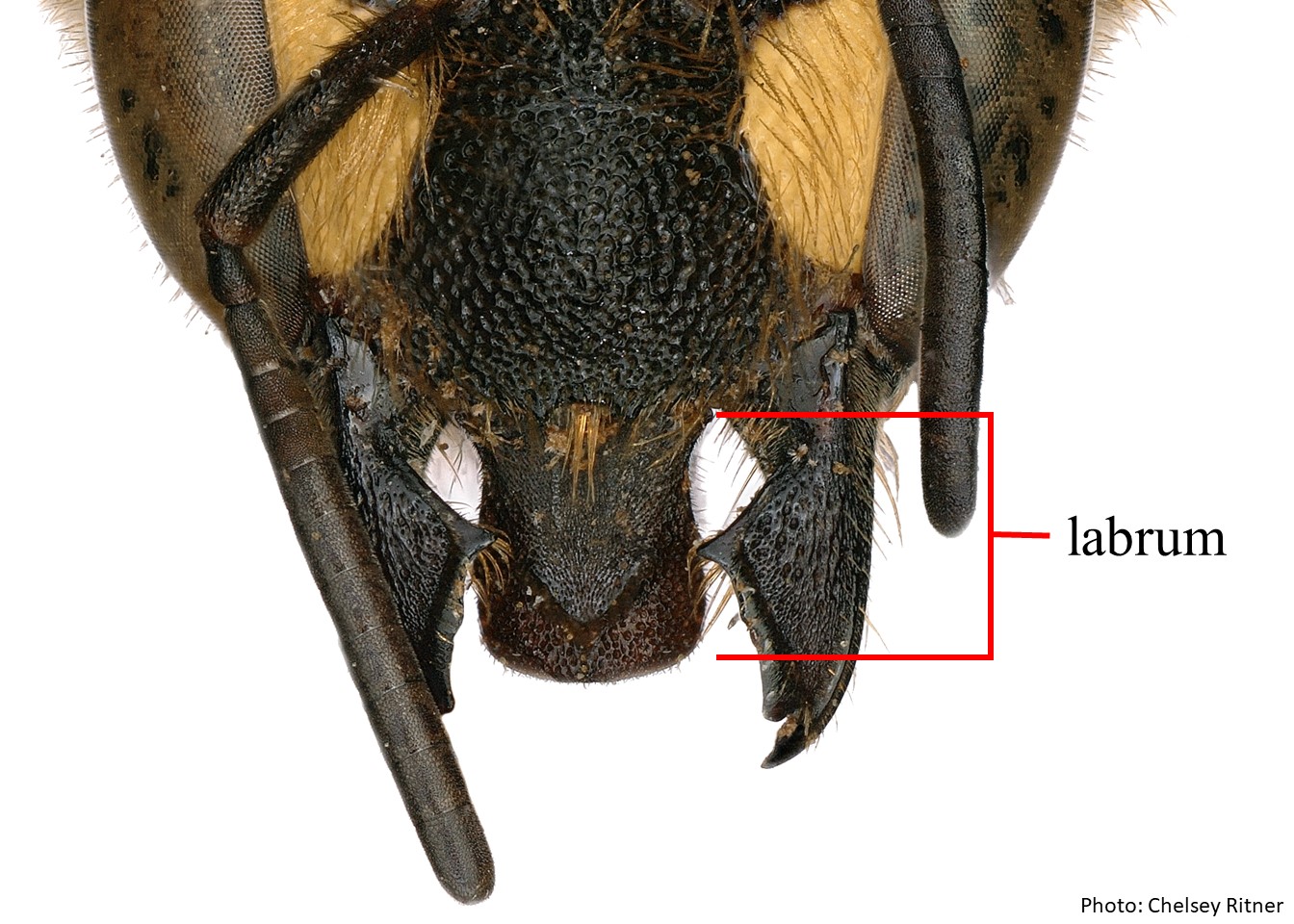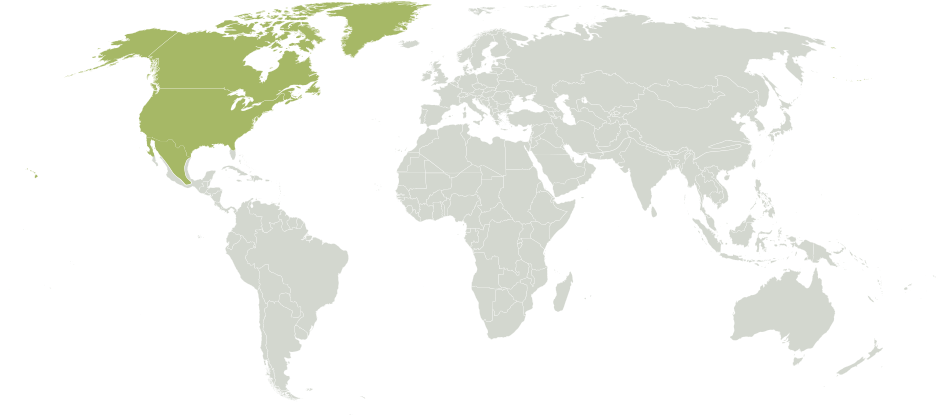Family: Megachilidae
Subfamily: Megachilinae
Tribe: Anthidiini
Genus: Anthidium Fabricius, 1804
Subgenus: A. (Anthidium) Fabricius, 1804
Species: Anthidium clypeodentatum Swenk, 1914
Common name: none
Anthidium (Anthidium) clypeodentatum are black with yellow or cream-colored maculations and some dark brown coloration on their antennae, legs, and sternasterna:
the plates on the underside of the abdomen, often abbreviated when referring to a specific segment to S1, S2, S3, S4, S5, S6, S7, or S8
 . This species has two color morphs based on its location. Northern species have cream-colored markings, which are absent on the female’s face, mandiblemandible:
. This species has two color morphs based on its location. Northern species have cream-colored markings, which are absent on the female’s face, mandiblemandible:
bee teeth, so to speak, usually crossed and folded in front of the mouth, and T6T6:
the segments on the top side of the abdomen, often abbreviated when referring to a specific segment to T1, T2, T3, T4, T5, T6, or T7 (Gonzalez and Griswold 2013Gonzalez and Griswold 2013:
(Gonzalez and Griswold 2013Gonzalez and Griswold 2013:
Gonzalez, V.H. and T.L. Griswold. 2013. Wool carder bees of the genus Anthidium in the Western Hemisphere (Hymenoptera: Megachilidae): diversity, host plant associations, phylogeny, and biogeography. Zoological Journal 168: 221ndash;425.). Species on the Nevada-California border have yellow markings, which are present on the female’s face, clypeusclypeus:
a section of the face below the antennae, demarcated by the epistomal sutures, T1–T6, and sometimes the mandiblemandible:
bee teeth, so to speak, usually crossed and folded in front of the mouth (Gonzalez and Griswold 2013Gonzalez and Griswold 2013:
Gonzalez, V.H. and T.L. Griswold. 2013. Wool carder bees of the genus Anthidium in the Western Hemisphere (Hymenoptera: Megachilidae): diversity, host plant associations, phylogeny, and biogeography. Zoological Journal 168: 221ndash;425.). Females have white or yellow pubescencepubescence:
short, fine hair
, which is darker on the fore and mid basitarsibasitarsi:
the segment of the tarsus that is the nearest to the body of the bee, usually the largest of all the tarsal segments, the inner hind basitarsibasitarsi:
the segment of the tarsus that is the nearest to the body of the bee, usually the largest of all the tarsal segments, and occasionally on S6S6:
the plates on the underside of the abdomen, often abbreviated when referring to a specific segment to S1, S2, S3, S4, S5, S6, S7, or S8
 . Females range in body length from 8.3–11.1 mm (Gonzalez and Griswold 2013Gonzalez and Griswold 2013:
. Females range in body length from 8.3–11.1 mm (Gonzalez and Griswold 2013Gonzalez and Griswold 2013:
Gonzalez, V.H. and T.L. Griswold. 2013. Wool carder bees of the genus Anthidium in the Western Hemisphere (Hymenoptera: Megachilidae): diversity, host plant associations, phylogeny, and biogeography. Zoological Journal 168: 221ndash;425.). Males have yellow or brown pubescencepubescence:
short, fine hair
on the vertexvertex:
the area between the ocelli and the back of the head, scutumscutum:
the large segment on top of the thorax located between the wings and behind the head
, and scutellumscutellum:
shield shaped plate behind scutum, and white hairs on the basitarsibasitarsi:
the segment of the tarsus that is the nearest to the body of the bee, usually the largest of all the tarsal segments. Males range in body length from 8.5–13.8 mm (Gonzalez and Griswold 2013Gonzalez and Griswold 2013:
Gonzalez, V.H. and T.L. Griswold. 2013. Wool carder bees of the genus Anthidium in the Western Hemisphere (Hymenoptera: Megachilidae): diversity, host plant associations, phylogeny, and biogeography. Zoological Journal 168: 221ndash;425.).
(modified from Gonzalez and Griswold 2013Gonzalez and Griswold 2013:
Gonzalez, V.H. and T.L. Griswold. 2013. Wool carder bees of the genus Anthidium in the Western Hemisphere (Hymenoptera: Megachilidae): diversity, host plant associations, phylogeny, and biogeography. Zoological Journal 168: 221ndash;425.)
 has a posterior surface covered in short, white tomentumtomentum:
has a posterior surface covered in short, white tomentumtomentum: has large, pre-apical projections, and lacks a basalbasal:
has large, pre-apical projections, and lacks a basalbasal: has a narrow projection on the mid-apical margin, and lacks a laterallateral:
has a narrow projection on the mid-apical margin, and lacks a laterallateral: has low basalbasal:
has low basalbasal: has thick, reddish-brown hairs.
has thick, reddish-brown hairs. basalbasal:
basalbasal: median lobe is small and triangular.
median lobe is small and triangular. is slightly rounded.
is slightly rounded. distaldistal:
distaldistal:Anthidium clypeodentatum may be confused with A. psoraleae due to the presence of short, white tomentumtomentum:
a form of pubescence composed of short matted, woolly hair
on the antennal scapescape:
the basal, and usually the longest, segment of the antennae , the medial projection on T6T6:
, the medial projection on T6T6:
the segments on the top side of the abdomen, often abbreviated when referring to a specific segment to T1, T2, T3, T4, T5, T6, or T7 in females, and a broad, laterallateral:
in females, and a broad, laterallateral:
relating, pertaining, or attached to the side
lobe on T7T7:
the segments on the top side of the abdomen, often abbreviated when referring to a specific segment to T1, T2, T3, T4, T5, T6, or T7 with a sharp, angled inner margin in males (Gonzalez and Griswold 2013Gonzalez and Griswold 2013:
with a sharp, angled inner margin in males (Gonzalez and Griswold 2013Gonzalez and Griswold 2013:
Gonzalez, V.H. and T.L. Griswold. 2013. Wool carder bees of the genus Anthidium in the Western Hemisphere (Hymenoptera: Megachilidae): diversity, host plant associations, phylogeny, and biogeography. Zoological Journal 168: 221ndash;425.). Female A. clypeodentatum can be differentiated from A. psoraleae by the presence of a strongly toothed or tuberculate distaldistal:
place on a segment that is furthest from the place of attachment with the body
margin of the clypeusclypeus:
a section of the face below the antennae, demarcated by the epistomal sutures, and the lack of a laterallateral:
relating, pertaining, or attached to the side
spine on T6T6:
the segments on the top side of the abdomen, often abbreviated when referring to a specific segment to T1, T2, T3, T4, T5, T6, or T7 (Gonzalez and Griswold 2013Gonzalez and Griswold 2013:
(Gonzalez and Griswold 2013Gonzalez and Griswold 2013:
Gonzalez, V.H. and T.L. Griswold. 2013. Wool carder bees of the genus Anthidium in the Western Hemisphere (Hymenoptera: Megachilidae): diversity, host plant associations, phylogeny, and biogeography. Zoological Journal 168: 221ndash;425.). Male A. clypeodentatum can be differentiated from A. psoraleae by the presence of a small and triangular median lobe on S6S6:
the plates on the underside of the abdomen, often abbreviated when referring to a specific segment to S1, S2, S3, S4, S5, S6, S7, or S8
 (Gonzalez and Griswold 2013Gonzalez and Griswold 2013:
(Gonzalez and Griswold 2013Gonzalez and Griswold 2013:
Gonzalez, V.H. and T.L. Griswold. 2013. Wool carder bees of the genus Anthidium in the Western Hemisphere (Hymenoptera: Megachilidae): diversity, host plant associations, phylogeny, and biogeography. Zoological Journal 168: 221ndash;425.).
Anthidium clypeodentatum adults have been recorded in flight from April to August, with peak activity occurring from June to the first half of August (Gonzalez and Griswold 2013Gonzalez and Griswold 2013:
Gonzalez, V.H. and T.L. Griswold. 2013. Wool carder bees of the genus Anthidium in the Western Hemisphere (Hymenoptera: Megachilidae): diversity, host plant associations, phylogeny, and biogeography. Zoological Journal 168: 221ndash;425.).
Anthidium clypeodentatum is a generalist that favors Lotus and Astragalus (Fabaceae). However, they have been observed visiting a variety of species within Asteraceae, Fabaceae, and Rosaceae (Gonzalez and Griswold 2013Gonzalez and Griswold 2013:
Gonzalez, V.H. and T.L. Griswold. 2013. Wool carder bees of the genus Anthidium in the Western Hemisphere (Hymenoptera: Megachilidae): diversity, host plant associations, phylogeny, and biogeography. Zoological Journal 168: 221ndash;425.).
Nesting behavior is unknown.
Anthidium clypeodentatum is one of the most widely distributed NearcticNearctic:
biogeographical region comprising North America as far south as northern Mexico, together with Greenland species. It occurs throughout western Canada in Yukon, British Columbia, Alberta, and Saskatchewan (Gonzalez and Griswold 2013Gonzalez and Griswold 2013:
species. It occurs throughout western Canada in Yukon, British Columbia, Alberta, and Saskatchewan (Gonzalez and Griswold 2013Gonzalez and Griswold 2013:
Gonzalez, V.H. and T.L. Griswold. 2013. Wool carder bees of the genus Anthidium in the Western Hemisphere (Hymenoptera: Megachilidae): diversity, host plant associations, phylogeny, and biogeography. Zoological Journal 168: 221ndash;425.). Within the U.S., A. clypeodentatum is found in Montana, North Dakota, South Dakota, and Colorado, and from California and Arizona to Washington. Within Mexico, it is distributed throughout northern Baja California. They are primarily found in chaparral, margins of the desert, and upper elevations of shrub steppe, montane forests, and grasslands (Gonzalez and Griswold 2013Gonzalez and Griswold 2013:
Gonzalez, V.H. and T.L. Griswold. 2013. Wool carder bees of the genus Anthidium in the Western Hemisphere (Hymenoptera: Megachilidae): diversity, host plant associations, phylogeny, and biogeography. Zoological Journal 168: 221ndash;425.).
Distribution map generated by Discover Life -- click on map for details, credits, and terms of use.
Gonzalez, V.H. and T.L. Griswold. 2013. Wool carder bees of the genus Anthidium in the Western Hemisphere (Hymenoptera: Megachilidae): diversity, host plant associations, phylogeny, and biogeography. Zoological Journal of the Linnean Society 168: 221-425.